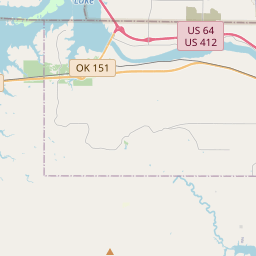The Bridge that Saved Tulsa
Historical marker location:
Tulsa, Oklahoma
( Marker is on Riverside Drive, on the left when traveling north.)







© OpenStreetMap contributors
More history nearby
During the Great Depression, thousands of farmers in Oklahoma were displaced from their land due to drought and dust storms. Many of these farmers migrated to California in search of work, a journey that became known as the "Okie migration."
About Tulsa County
Tulsa County Timeline
Tulsa County, Oklahoma's history dates back thousands of years, as it was originally inhabited by various Indigenous peoples, including the Osage, Creek, and Cherokee tribes. The land later came under the ownership of the United States government through various treaties and the forced removal of Indigenous peoples to reservations in the 19th century.
The modern history of Tulsa County began in 1882, when the Creek Nation sold a portion of its land to the Atlantic and Pacific Railroad, leading to the establishment of a settlement known as "Tulsey Town." The town grew rapidly, attracting settlers and becoming a bustling center for trade and commerce. In 1901, Tulsa officially incorporated as a city, with oil being discovered in the area shortly after.
The early 20th century witnessed an oil boom in Tulsa County, transforming the city into the "Oil Capital of the World." The population skyrocketed, and oil barons built stunning mansions along what is now known as "Millionaire Row." The wealth generated by the oil industry fueled the growth of numerous industries, including aviation.
Tulsa County also holds a tragic chapter in its history. In 1921, it experienced one of the deadliest incidents of racial violence in U.S. history, known as the Tulsa Race Massacre. A prosperous African American community called Greenwood was destroyed, resulting in the deaths of hundreds of people and the displacement of thousands. The event remained largely hidden from history until recent years.
Today, Tulsa County is a diverse and vibrant community, known for its rich oil heritage, vibrant arts scene, and growing economy. The city has made efforts to acknowledge and address the historical trauma of the Tulsa Race Massacre, including the establishment of the Greenwood Cultural Center and the ongoing process of searching for mass grave sites. Tulsa County continues to thrive as a regional hub of business, culture, and education.
The modern history of Tulsa County began in 1882, when the Creek Nation sold a portion of its land to the Atlantic and Pacific Railroad, leading to the establishment of a settlement known as "Tulsey Town." The town grew rapidly, attracting settlers and becoming a bustling center for trade and commerce. In 1901, Tulsa officially incorporated as a city, with oil being discovered in the area shortly after.
The early 20th century witnessed an oil boom in Tulsa County, transforming the city into the "Oil Capital of the World." The population skyrocketed, and oil barons built stunning mansions along what is now known as "Millionaire Row." The wealth generated by the oil industry fueled the growth of numerous industries, including aviation.
Tulsa County also holds a tragic chapter in its history. In 1921, it experienced one of the deadliest incidents of racial violence in U.S. history, known as the Tulsa Race Massacre. A prosperous African American community called Greenwood was destroyed, resulting in the deaths of hundreds of people and the displacement of thousands. The event remained largely hidden from history until recent years.
Today, Tulsa County is a diverse and vibrant community, known for its rich oil heritage, vibrant arts scene, and growing economy. The city has made efforts to acknowledge and address the historical trauma of the Tulsa Race Massacre, including the establishment of the Greenwood Cultural Center and the ongoing process of searching for mass grave sites. Tulsa County continues to thrive as a regional hub of business, culture, and education.
Tulsa County Timeline
This timeline provides a condensed summary of the historical journey of Tulsa County, Oklahoma.
- 1836 - The area that would later become Tulsa County is part of the Creek Nation's land in the Indian Territory.
- 1836 - The Treaty of New Echota results in the forced removal of the Creek Nation to the Indian Territory.
- 1861-1865 - The Civil War results in the Indian Territory being divided into Confederate and Union territories.
- 1870s - The first settlements are established in the area, including Tulsey Town, which later becomes Tulsa.
- 1901 - Tulsa becomes incorporated as a city.
- 1905 - Tulsa County is established, with Tulsa as its county seat.
- 1921 - The Tulsa Race Massacre occurs, resulting in the destruction of the prosperous African American community of Greenwood.
- 1928 - The first oil discovery in Tulsa County leads to a boom in the oil industry and economic growth.
- 1957 - The construction of the Arkansas River Navigation System allows for barge transportation, boosting trade and commerce in the area.
- 1980s - Tulsa experiences an economic downturn due to the collapse of the oil industry.
- 2000s - Tulsa undergoes revitalization efforts with the development of the BOK Center, Gathering Place, and other projects.